
Anthurium, is a genus of about 1000 species of flowering plants, the largest genus of the arum family, Araceae. General common names include anthurium, tailflower, flamingo flower, and laceleaf.

Spathiphyllum is a genus of about 47 species of monocotyledonous flowering plants in the family Araceae, native to tropical regions of the Americas and southeastern Asia. Certain species of Spathiphyllum are commonly known as spath or peace lilies.
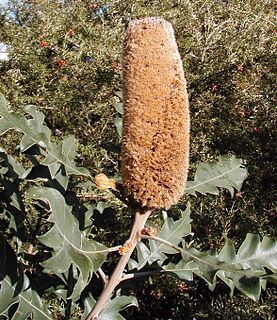
Banksia solandri, commonly known as Stirling Range banksia, is a species of large shrub in the plant genus Banksia. It occurs only within the Stirling Range in southwest Western Australia. Its scientific name honours the botanist Daniel Solander, one of the first collectors of Banksia.

Phormium colensoi (syn. Phormium cookianum ; wharariki, whararipi, whatariki, mangaeka, kōrari tuauru, wauraki, mountain flax, coastal flax, hill flax, lesser New Zealand flax, is a perennial plant that is endemic to Aotearoa New Zealand. It is less common than the other Phormium species, harakeke P. tenax J.R.Forst. et G.Forst. The greenish, yellow or orange flowers are followed by twisted seed pods.

Prosartes hookeri is a North American species of flowering plants in the lily family known by the common names drops of gold and Hooker's fairy bells.
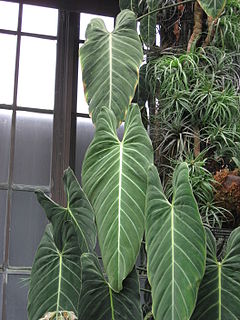
Philodendron melanochrysum is a species of flowering plant in the family Araceae, endemic to the wet Andean foothills of Colombia, growing at approximately 500m above sea level in the provinces of Chocó and Antioquia but widely cultivated elsewhere as an ornamental.

Calibanus is a genus of two species of flowering plants, both evergreen succulents from dry areas of northeastern Mexico. The APG III classification system places it in the family Asparagaceae, subfamily Nolinoideae It was formerly included in the Agavaceae but is now separated from them, for it is polycarpic and dioecious. Its name refers to the monster Caliban, an antagonist in Shakespeare's The Tempest.
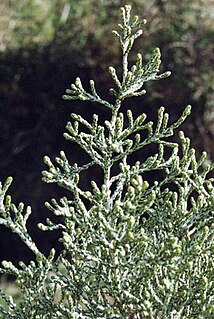
Ozothamnus hookeri, commonly known as kerosene bush, is an aromatic shrub species, endemic to Australia. It grows to between 0.5 and 1 metre in height and has white-tomentose branchlets. The scale-like leaves are 4 to 5 mm long and 0.5 to 1 mm wide. These are green on the upper surface, and white tomentose below. The flower heads appear in dense clusters in summer and autumn The species occurs in boggy sites and subalpine heathland New South Wales and Tasmania.

Scaevola hookeri, the creeping fan-flower or alpine fan-flower, is a prostrate perennial herb in the family Goodeniaceae. It is native to eastern Australia. Leaves are 6 to 50 mm long and 2 to 15 mm wide. Flowers are white or blue with a yellowish throat and appear between December and March in the species' native range. The species was first formally described by W.H. de Vriese in 1850 in Nederlandsch Kruidkundig Archief and given the name Merkusia hookeri. The species was transferred to the genus Scaevola in 1856. It occurs in grassland and woodland in high altitude areas in Victoria, New South Wales, Tasmania, and also South Australia where it is listed as "endangered".

Anthurium andraeanum is a flowering plant species in the family Araceae that is native to Colombia and Ecuador. A winner of the Royal Horticultural Society's Award of Garden Merit, it is one of the plants listed in the NASA Clean Air Study as effective in removing formaldehyde, xylene, toluene, and ammonia from the air.
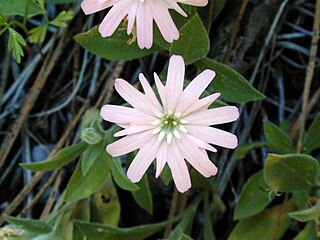
Silene hookeri is a species of flowering plant in the family Caryophyllaceae known by the common names Hooker's silene, Hooker's catchfly, Hooker's Indian pink, and Hooker's glandular campion.
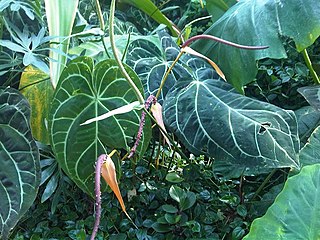
Anthurium crystallinum is a species of flowering plant in the family Araceae, native to rainforest margins in Central and South America, from Panama to Peru. Growing to 90 cm (35 in) tall and broad, it is an epiphytic perennial, characterised by large, velvety oval leaves with prominent white veining, and inflorescences with green spathes and pale green spadices throughout the year.
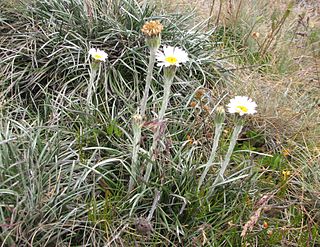
Celmisia pugioniformis, commonly known as slender snow-daisy, is a species of perennial herb in the family Asteraceae. It is native to south-eastern Australia. Leaves are 10 to 20 cm long and 2 to 6 mm wide, with an olive green or grey green upper surface. The daisy-like flowerheads, which are 6 to 8 cm in diameter, appear between December and February in the species native range. The species was formally described in 1992 in the Flora of New South Wales. Prior to 1992, plants had been included under the name Celmisia asteliifolia.
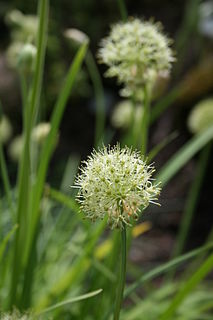
Allium hookeri is a plant species native to India, Sri Lanka, Myanmar (Burma), Bhutan, and southwestern China. Common names include Hooker chives and garlic chives. The plant is widely cultivated outside its native range, and valued as a food item in much of South and Southeast Asia.

Balsamorhiza hookeri is a North American species of perennial plant in the sunflower family. It grows in the Great Basin and neighboring regions in the western United States. It is found in Washington, Oregon, California, Idaho, Nevada, Utah, and Arizona.

Anthurium schlechtendalii, also known as pheasants tail or cola de fasian in Spanish, is a broad-leafed plant used for multiple medicinal purposes, including muscle and joint sprains, back pain, arthritis and rheumatism.

Drosera hookeri, the grassland sundew is an shortly erect perennial tuberous species in the carnivorous plant genus Drosera. Drosera hookeri is found in south-eastern Australia. Although the holotype was collected in Tasmania, its distribution also includes Victoria, New South Wales and South Australia. This species has a complex taxonomic history, and its specific epithet acknowledges the original recognition of the taxon by Joseph Dalton Hooker. Hooker originally called his species Drosera foliosa Hook.f. ex Planch. in 1848, a name that was illegitimate as it had previously been used to describe a different species. The nomenclature of D. hookeri was later clarified and the taxonomic concept significantly broadened to include most of the south-eastern Australian and New Zealand forms of the species complex that includes Drosera peltata.

Anthurium veitchii, the king anthurium, is an epiphytic species of flowering plant in the genus Anthurium native to Colombia. It is grown in more temperate climates as a greenhouse or houseplant for its large, pendulous leaves that can be several feet long.
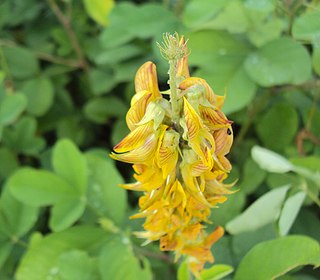
Crotalaria pallida, commonly known as the smooth crotalaria, is a species of flowering plant within the family Fabaceae.
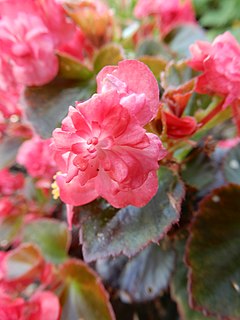
Begonia cucullata, also known as wax begonia and clubed begonia, is a species of the Begoniaceae that is native to South American countries of Argentina, Brazil, Paraguay, and Uruguay. A common garden plant and part of the section Begonia, it was described in 1805 by Carl Ludwig Willdenow (1765–1812). The specific epithet "cucullata" means "resembling a hood" or "hooded".




















